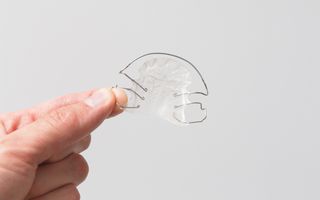Orthodontics
Correcting tooth alignment with aligners, braces and orthodointic plates

Orthodontic treatments help to correct teeth alignment, enhance appropriate tooth growth and usage, and create a straighter, healthier smile. Although some people believe that braces are only for teenagers, orthodontic treatments can improve the dental health of individuals of all ages.
Types of Orthodontic Treatments
Dental braces are not what they used to be. A variety of new techniques and equipment have been developed to enhance the patient's experience and shorten treatment times.
There are a wide variety of orthodontic treatments available, and the correct treatment depends largely on the individual needs of the patient.
Some treatments, such as orthodontic plates, are best for young children whose teeth and jaws are still growing, while treatments with low visibility, such as Invisalign®, may be ideal for adults.
Some of the most common orthodontic treatments include:
Fixed metal braces
Traditionally fixed or orthodontic braces are high-quality metal brackets that are attached to each tooth. These brackets are then connected by a special type of wire, which slowly pulls the teeth into alignment.
Over time, your dentist or orthodontist will make a series of adjustments to straighten the teeth to achieve the desired outcome. More contemporary braces are much more streamlined than traditional braces, and modern technology allows for the brackets to be discreetly matched to your tooth enamel.

What can traditional braces help with?
Some common issues that orthodontists may improve with fixed braces include:
- Crowded teeth
- Crooked teeth
- Underbites, overbites and crossbites
- Limited breathing
- Unevenly spaced teeth
- Gapped teeth
Ceramic braces
Like metal braces, ceramic braces use wires and brackets; however, the brackets are clear or off-white ceramic to disguise the appearance of the braces.
Ceramic is also smoother than metal, which can make this type of brace more comfortable to wear.
Lingual braces
Lingual braces use the same metal brackets and wires as metal braces, but on the inner surface of the patient's teeth so that they can't be seen.
As well as being essentially invisible to others, lingual braces can offer benefits for your teeth. With braces that are attached to the front of your teeth, there is a risk of decalcification (the removal of calcium), however, the backs of the teeth are more robust, so the risk is lower at the back.
Clear aligners
Clear aligners are one of the most sought-after types of orthodontic treatment for adults.
Most commonly known by the manufacturer's name, such as Invisalign® or ClearCorrect, aligners are created using advanced technology. This includes a series of aligners custom-made for your mouth that apply targeted pressure to your teeth, which gradually moves them into alignment as you move through your set of aligners.

What are the benefits of clear aligner treatment?
Clear aligners have become extremely popular due to their subtle appearance. They are transparent in colour, almost invisible, and custom-made to fit snugly on your teeth. There are many advantages to using clear aligners over traditional braces:
- They are almost invisible and have a discreet appearance.
- They're removable, so you can take them out for eating, drinking, and photos.
- They are easy to clean when you take them out.
- They're more comfortable as they are custom-made to fit your mouth.
- They can usually straighten your teeth in a shorter amount of time.
Orthodontic plates and retainers
For young children who have particular problems with tooth or jaw alignment, orthodontic plates can be used to carefully adjust the growth of the jawbone and arrange the teeth.
An orthodontic plate, or retainer, consists of plastic or wire that is shaped to fit around the top or bottom teeth to hold them in place or gently guide them into the desired position.
Judicious use of orthodontic plates at a young age can significantly reduce or eliminate the need for braces later in life. Retainers are often used after treatment with braces to ensure that the teeth remain in position.

Who can benefit from an orthodontic treatment?
There are a wide variety of conditions that can be improved through the use of orthodontic treatment. Although age is a consideration, it is not the only factor in the orthodontist's choice of treatment.
Conditions that may require the use of orthodontic treatments include:
- Poor alignment of top and bottom molars that complicate or prevent chewing.
- A crossbite, in which the upper teeth rest behind the lower teeth.
- A deep bite or overbite, in which the upper front teeth cover the front of the lower front teeth.
- An open bite, in which the front teeth do not touch at all when biting.
- Teeth that are misaligned, angled, crowded, or spaced too far apart.
- Jaw / joint pain (TMD) and headaches due to clenching and misaligned teeth.
- Tooth decay, bone loss, and excessive wear on the surface of the teeth due to poor alignment.
To determine the best treatment option for your needs, your dentist will conduct a comprehensive examination and assessment of your dental condition. If your condition can't be treated by a general dentist, you will receive a referral to a specialist.
Care and maintenance
When you wear braces, aligners, or retainers, it will be necessary to adjust your eating habits to prevent damage to both the hardware and your teeth.
We recommend avoiding hard foods and sticky sweets that can break or pull your braces from your teeth such as gum, toffee, popcorn, nuts, hard biscuits, etc. You should also avoid biting into foods with your front teeth. Rather, cut foods into manageable pieces that you can chew with your back teeth.
Braces can trap food in your mouth after you eat, so be sure to brush and floss after every meal. Continue to floss and brush your teeth regularly, but be sure to use the special brushes and flossing tools recommended (and typically provided) by your orthodontist.
Specialised floss brushes and mouthwash are particularly useful for cleaning out braces after a meal. Carry a small cleaning kit with you to school or work, so you have the supplies you need on hand to keep your braces and teeth in ideal condition.
To learn more about the best orthodontic services for you, get in touch with our friendly team to schedule an appointment.
Frequently asked questions
The price of dental braces will vary dependant on a number of factors... such as the length of time you will need to wear them, how many consultations and adjustments you need and other factors tha will be specific to you.
While braces are highly effective, they do usually come with discomfort as your teeth move into new positions. This usually lasts for a few days after first having them applied, and after adjustments, where your teeth and gums will feel tender.
During these days, you can manage pain with over-the-counter pain medications and eat a diet of soft foods - ie. no apples, uncooked carrots, hard biscuits, etc.
Yes! Dental technology has come a long way from the early days of metal braces, and clear aligners are now just as effective as metal braces.
An orthodontist is a specialist who works to ensure your teeth are straight and your jaw is aligned. They will prepare your teeth for orthodontic treatments, carry out treatments such as braces, maintain and adjust appliances as needed, and keep ongoing appointments with you as you transition out of treatment.
A dentist is your general expert on your teeth, gums, and oral health. They will perform your check-ups, complete treatments such as fillings, root canals, and crowns, and help you work on your health.
An orthodontist is a specialist who focuses on teeth straightening and alignment and can apply braces and other orthodontic treatments.
Once your orthodontic treatment is completed and your braces are removed, you will be fitted with a retainer to ensure that your teeth remain in their new alignment.
Be sure to wear your retainers as directed, or you may undo all the previous work. Do not wear your retainer while eating, and be sure to brush it before you insert it into your mouth.
For patients who do not wish to use a removable retainer, a permanent wire retainer can be cemented to the back of the teeth to keep them in place.

